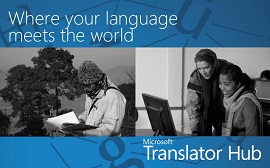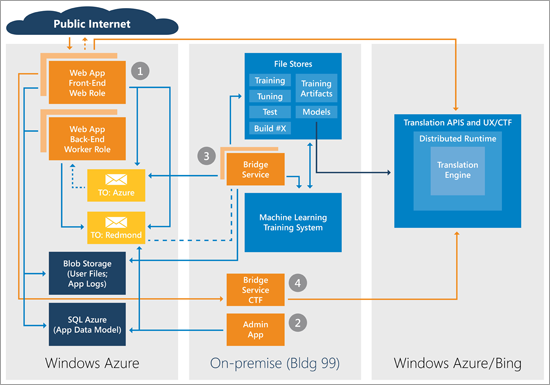 Microsoft Translator Hub empowers businesses and communities to build, train, and deploy customized automatic language translation systems—bringing better and specialized translation quality to established languages, and first-time automatic translation capabilities to the many languages that are not yet supported by major translation providers.
Microsoft Translator Hub empowers businesses and communities to build, train, and deploy customized automatic language translation systems—bringing better and specialized translation quality to established languages, and first-time automatic translation capabilities to the many languages that are not yet supported by major translation providers.
Microsoft Translator Hub is free and easy to use—you need not be a linguist or machine translation expert. Get started with your language translation.
-
Background
Automatic language translation has been dominated by a few major providers, resulting in coverage that is limited to fewer than 100 languages—even though there are more than 7,000 languages in the world. Speakers of these other languages must adopt non-indigenous languages to be able to access the global knowledge base—or they risk being excluded from the vast wealth of information it offers.
Microsoft Translator Hub empowers users to build translation models that help preserve indigenous languages. It also allows the creation of translations within a given language that are scoped to the specific interests of a community or organization—ranging from transportation and agriculture to healthcare and technology.
-
Features and Benefits
Translation between any two languages via a web-accessible system in a private workspace.
- Create, improve, and deploy custom translation systems.
- Develop automated language translation between virtually any pair of languages via cloud and web services.
- Instead of passing through a pivot language, which is how the large commercial systems work, related languages can take advantage of their structural similarities.
Cultural and language preservation—the ability to translate lesser-known languages helps keep native languages alive and helps preserve native cultures.
- Communities can develop translations for languages that are not presently supported, increasing public access to global information.
- Communities can evaluate and improve the system themselves in a private workspace.
Crowdsourcing—designated members of the public can participate to help improve the translation system.
- The reviewer UI allows trusted reviewers to accept, reject, or edit changes submitted by the community.
- The model remains accessible only to the project owner and trusted invited members until it is ready to deploy.
Domain-specific models—users can build highly customized systems that are scoped to specific domains of interest.
- Organizations can develop systems that are tailored to their needs: such as translation for targeted localization or social media.
- Publishers can use previously translated content for a technical domain (such as chemistry) to help train the system to translate content in the same domain.
- With the ability to translate into the local language, organizations working to improve the quality of life in emerging nations can tap into the global knowledge base and target specific topics of interest, such as healthcare and agriculture.
Powered by Microsoft Translator technology—systems benefit from powerful technology and big translation models.
-
The machine-learning technology learns a language very much in the same way that a human does—through exposure and immersion.
- Companies building general or targeted translation models can use models Microsoft has created for the languages that they are translating.
- Microsoft Translator’s general-purpose models facilitate the development of domain-specific models to create “cottage industry” machine-translation systems that can be deployed in a private workspace.
Advances in machine-translator research—Microsoft Translator development contributes to the body of research on domain-specific translation models as well as research on improved machine translation between two languages.
-
How Microsoft Translator Hub Works
Powered by Windows Azure (opens in new tab), Microsoft Translator Hub is an extension to the Microsoft Translator (opens in new tab) platform and service. You can build your translation system easily within a private website by combining your translated documents with the power of Microsoft Translator. Once you are satisfied with your translation, you can share your language translation publicly on the web with the rest of the world.

Microsoft Translator Hub Architecture
The process for translating from one language to another can be broken down into four basic steps:

You create a set of documents that are commonly referred to as parallel documents, which is the same document written in two languages: the languages you are translating from (the source language), and the language you are translating to (the target language). Together, the two languages are described as a language pair.

By using the parallel documents, Microsoft Translator Hub is able to “learn”:
- How words, phrases, and sentences are commonly translated.
- How to process the appropriate context, depending on the surrounding phrases; a particular word may not always translate the same way.
- How verbs are conjugated and nouns inflected, depending on the context of the surrounding text.

Your reviewers make recommendations on how to further refine the translation, based on the results of the training output. This process can be repeated as necessary until an acceptable level of quality has been achieved, and the translation system is ready for deployment.

Once deployed, these services are web accessible by using the standard Microsoft Translator APIs—HTTP, AJAX, and SOAP interfaces, as well as a webpage widget.
Within each of these steps, there are several activities that need to be completed, and once you’ve signed in to Microsoft Translator Hub, more detailed instructions are provided, as well as tutorial videos, to help you along.
-
Links
Microsoft Translator Hub
- Try Microsoft Translator Hub (opens in new tab)
- Microsoft Translator Hub Overview (opens in new tab)
Related Links
- No Language Left Behind (opens in new tab)
- Microsoft Research Machine Translation Project (opens in new tab)
- Microsoft Local Language Program (opens in new tab)
Technologies
“Our goal is to further scientific research, enable equality in education, and improve human-technology interactions. What can be more natural than learning and experiencing technology in your own language?”
—Kristin M. Tolle, director, Microsoft Research Connections, and clinical associate professor, University of Washington School of Public Health
人员
Christophe Poulain
Principal Software Development Engineer
Vishal Chowdhary
Partner Development Manager
